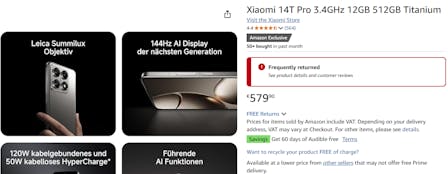Amazon’s “Frequently Returned” Badge Just Got More Visible
Amazon has quietly increased the visibility of a warning that most brands would prefer customers never see: the “Frequently returned item” badge. While this label isn’t new, it’s now far more prominent, placed directly above the bullet points in dark red with an attention icon. In testing, it’s already proving to be a conversion killer.
This can send a clear negative signal at a crucial decision point in the customer journey. Even for products with otherwise solid reviews, this badge can undermine trust, slow conversion, and reduce sales velocity.
The Risk Behind the Badge
So, what triggers the “Frequently returned” badge? This is more than a design change. It marks a shift in how Amazon publicly surfaces product quality issues. The badge appears when Amazon’s systems detect that a product is returned more frequently than similar items, usually due to customer dissatisfaction tied to misaligned expectations.
Premium products can also be flagged if key details around size, material, or function aren’t properly communicated. Once triggered, the badge becomes a very visible penalty for PDPs (Product Detail Page) that don’t hold up under real customer experience.

How We Help Brands Stay Ahead
Amazon doesn’t issue alerts when this badge is applied. And by the time it shows up on your product detail page, damage may already be done.
But what if you could identify potential risks before they impact your brand? At Front Row, we help clients stay ahead of this risk with a focused approach. We actively track and flag products that may be at risk using:
- Amazon’s Customer Satisfaction Dashboards
- Amazon’s Voice of Customer reports
- Our very own e-commerce analytics platform Catapult
- Keepa, which marks listings with high return classifications
These signals give us early insight into friction points, often before they reach a tipping point. It’s not just about avoiding negative badges but also leveraging positive ones (“Customers usually keep this item”) to reinforce product reliability and increase conversion.
Diagnosing Return Rate Drivers
High return rates are symptoms. We help clients get to the root cause. Whether it’s unclear lead imagery, vague sizing, or repeated product complaints that aren’t addressed in the content, we dig in and diagnose the disconnect.
Strategic PDP Optimization
Once we understand the problem, we help brands fix it where it matters most: the PDP. That could mean rewriting bullet points, updating visuals to better show scale or features, or inserting comparison charts to clarify sizing and reduce ambiguity.

A Visibility Metric, Not Just a Return Metric
This update is part of a broader trend. Amazon is tying customer satisfaction more directly to product visibility. Return rate is no longer just a post-purchase KPI, it’s something shoppers now see upfront.
While some products are flagged with the “Frequently returned” badge, others receive the reassuring “Customers usually keep this item” badge, signaling reliability and lower-than-average return rates.
For brands, this dual visibility metric presents both a risk and an opportunity: mitigate the negative, but also spotlight the positive to boost trust and sales velocity.
Whether it’s addressing the impact of a negative badge or capitalizing on a positive one, proactive monitoring, diagnosis, and listing alignment are essential to staying ahead. At Front Row, we specialize in exactly that.
